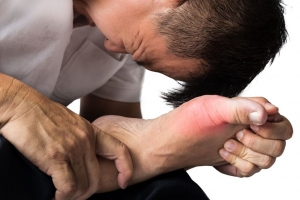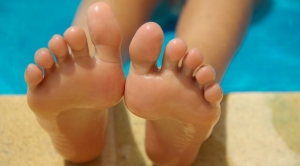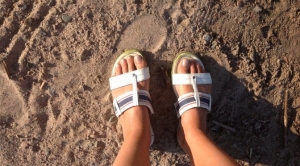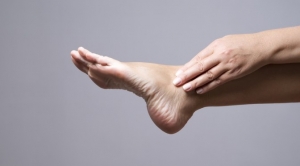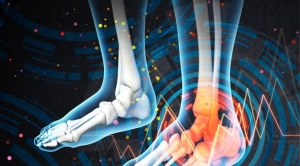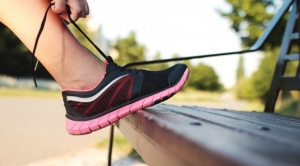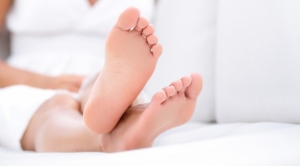Connect With Us
Blog
Displaying items by tag: Foot Health
Does Your Foot Pain Signal a Serious Condition?
You might be surprised to learn that many diseases have foot pain as one of their symptoms. Problems with the thyroid can cause nerve sensations in the feet; or degeneration in the lower back might irritate the nerves of the spine, impeding sensation in the feet. Learning what signs to look for could improve your life or even save it.
Peripheral Arterial Disease (PAD)
PAD occurs when plaque – a fatty substance which builds up in the arteries in the legs – reduces blood flow to the lower legs and feet. Symptoms include cramping in the calves, or other parts of the leg while it is in motion. It may even cause foot pain, or prevent wounds in the foot from healing properly.
While the most obvious symptoms of PAD involve the legs, it is associated with hidden damage to the heart and brain. This means that PAD sufferers are at a higher risk of heart attack and stroke. Smoking, diabetes, high cholesterol, and high blood pressure will also increase the risk of PAD. Medications may be prescribed, but diet and lifestyle changes are also necessary.
Rheumatoid Arthritis (RA) and Gout
The Arthritis Foundation revealed that 46 million Americans have arthritis or other chronic joint problems. Of the 1.3 million Americans who suffer from rheumatoid arthritis, 90 percent of them will experience symptoms in their foot and ankle.
RA develops when the body’s immune system mistakenly attacks the joints, causing pain and swelling. If RA reaches the feet, pain will begin in the toes, and then spread to the feet and ankles later on. The joint damage caused by RA can even change the shape of the toes and feet, given enough time. RA treatment involves medication, exercise, and sometimes surgery.
Gout is another type of arthritis caused by the accumulation of uric acid in the body. The acid collects in the joints, especially the big toes, and will cause intense, episodic pain. The acid may even cause kidney stones if it builds up there.
Gout treatment involves exercise, lots of water, avoidance of certain medications, and staying at a healthy weight. Doctors may prescribe gout patients with nonsteroidal anti-inflammatory drugs (NSAIDs), steroids, or other medications.
Diabetes
Approximately 24 million Americans have diabetes, but 6 million don’t even know it. Diabetes is a condition in which glucose, or blood sugar, builds up in the blood. While glucose is necessary to fuel the body, an excess amount will damage nerves and blood vessels in the feet, causing decreased sensation and reduced blood flow.
Other symptoms of diabetes include numbness and tingling in the feet, and severe foot infections. While many people experience foot discomfort after a long day of standing, severe foot pain out of proportion with your activity level is a problem that should be reported to your doctor. Diabetes can lead to other major foot problems as well, and possibly surgical removal of the toe, foot, or lower leg.
Diabetes can be treated with medication and regular foot exams. It also requires lifestyle changes like quitting smoking, and wearing supportive shoes to mitigate foot trauma.
For more information on foot pain or to schedule an appointment, contact Superior Foot & Ankle Care Center.
How Treat and Prevent Foot Blisters
Blisters are common, especially for those who do a lot of walking or running. However, many people don’t know how to care for their blisters properly. Here are some tips for healing any blisters you may already have, and how to avoid new ones from forming:
When You Can Remove a Blister
When blisters are small and do not show any signs of infection, it is perfectly okay to pop them. Simply disinfect the area and drain before the blister can become infected. Afterward, treat the wound with antibiotic ointment.
To safely pop your blister, you should:
- Thoroughly wash your hands and the blister with water and antibacterial soap. Then cleanse the blister with rubbing alcohol or iodine.
- Gently rub your blister to see if it will pop on its own. If it doesn’t, soak your feet in warm water for 30 minutes. Then try popping it again.
- Cover the wound with antibiotic ointment and a bandage.
When You it Shouldn’t Be Remove
If your blister shows signs of redness, swelling, soreness, pus, or even pain, do not pop it. All of these symptoms may indicate that you have a serious infection, or that your blister is actually a foot ulcer. Both of these conditions require the attention of a podiatrist to be treated properly. Foot ulcers, particularly for diabetics, can become gangrenous and result in the need for amputation. If you are experiencing any of these symptoms, or if you suspect that you have a foot ulcer, seek medical attention immediately.
Blister Treatment
Blisters are often sore while they are healing, so be sure to keep your feet comfortable. For example, put extra padding on the affected area, or use a healing ointment that also provides pain relief.
Blister Prevention
In order to prevent future blisters, make sure that you always wear shoes that fit properly. In addition, avoid going sock-less while wearing shoes like sneakers or boots, particularly if you’re going to be walking for a while. When you do wear socks, be sure that they are thick and provide extra padding in sensitive area like the back of the heel. Cotton socks absorb moisture, causing blisters when the wet socks rub against your feet.
People with foot abnormalities, such as bunions, often develop blisters. If you are constantly suffering from blistering feet, consult your foot care professional.
For more foot care tips and tricks, consult the experts at Superior Foot & Ankle Care Center with all of your podiatric questions and concerns.
15 Steps to Fabulous Summer Feet
Summer can be hard on your feet, making proper foot protection a priority. Here are 15 simple steps to healthy, beautiful feet all year round:
Use Sunscreen
Protect your feet the from harsh UV rays on sunny summer days. Apply sunscreen with SPF 15 or higher to protect your skin from cancer and premature aging. Also, remember to reapply your sunscreen after swimming or sweating, even if the sunscreen claims to be waterproof.
Avoid Walking Barefoot
Walking barefoot is always dangerous, but the intense summer heat increases your risk of sustaining foot injuries. It also puts you at risk of developing plantar warts, ringworm, athlete’s foot, and other infections on the soles of your feet.
Wash Feet
Wash your feet with warm water after wading in lakes, ponds, and other stagnant bodies of water. Still water breeds bacteria, leaving you vulnerable to infection.
Treat Yourself to a Pedicure
Treating yourself to regular pedicures will ensure that both your nails and feet look their best in your chic summer styles.
Stay Hydrated
Staying properly hydrated during the hot summer months will prevent swollen feet. Proper hydration also improves your circulation, which in turn helps you fight infection.
Moisturize
Your feet are drier in the summer since you’re no longer wearing socks. Apply plenty of moisturizer in the morning after your shower to lock-in the moisture. For the best results, reapply before bed.
Wear The Right Socks
Acrylic and synthetic blend socks like CoolMax work the best to wick perspiration, preventing fungal infection. Socks that do not wick perspiration, such as those made from 100% cotton, increase your risk of developing blisters.
Prevent Blisters
Sandals can often cause blisters when they rub against bare feet. If you feel a blister developing, use extra padding such as liquid bandages to protect the affected area. If a blister does develop, be sure to treat it with antibiotic ointment after it pops.
Keep Shoes and Socks Dry
If your shoes or socks get wet, remove them. Wearing wet footwear leaves you vulnerable to developing fungal infections and blisters. Always bring a spare pair of socks and shoes if your feet could potentially get soaked.
The Right Shoes for The Right Occasion
Whether you’re going camping, hiking, boating, or running, it’s always best to wear footwear designed for the activity. Wearing improper footwear during strenuous activity can result in serious injury.
Air Out Feet
Avoid wearing closed-toe shoes and reach for sandals to let your feet breathe. If closed-toe shoes are required, be sure to take them off periodically in order to keep your feet from sweating.
Evaluate Your Flip-Flops
Flip-flops tend to cause sore feet, but that doesn’t mean that you have to avoid them. Be sure to choose flip-flops with extra padding, and avoid walking long distances in them.
Add Cushioning to Shoes.
Many summer shoes do not provide the proper cushioning to keep your feet protected and pain-free. Due to this, you should replace the cushioning in your shoes whenever possible. There are many over-the-counter insoles that will add extra cushioning on the cheap.
Inspect Old Shoes.
Old, worn-out shoes can cause blisters and other foot injuries. Be sure to assess the condition of your summer shoes, and throw away any questionable pairs.
Fore more foot care tips and inspiration, contact the experts at Superior Foot & Ankle Care Center for all of your podiatric needs.
What Causes Ingrown Toenails
Toenails that curve and dig into the skin of your toe are called ingrown toenails. Sometimes even the size of the nail are covered in skin and become embedded in the toe. This is why you should always be sure to cut your toenails straight across to discourage the sides from growing into your skin. Any toe can develop an ingrown toenail however, it is often the big toe.
While ingrown toenails are not often serious medical problems they can be severely painful. And, if left untreated and uncared for properly ingrown toenails can become infected. This is why it is important to receive proper treatment for your ingrown toenails right away.
What causes ingrown toenails?
- Shoes that are too small because they squeeze the toes.
- Toenails being cut too short.
- A toenail that has become damaged or chips can become an ingrown toenail.
- Having toes are too small to accommodate proper nail growth.
People with congenital conditions that cause them to have toenails that are frequently larger or smaller than normal should take care to always trim their nails properly and maintain proper foot hygiene because they are at high risk of developing ingrown toenails.
You may also develop ingrown toenails after sustaining a foot injury, such as a broken foot.
Other ways to keep your feet/toes healthy.
- Keep your feet clean and dry
- Keep your feet safe in public areas where they are susceptible to contracting diseases like athlete’s foot.
- Wear breathable footwear
- Don’t share footwear
- Always wear shoes that fit you properly
- If your toenails are discolored be sure to not apply any nail polish to them. Discoloration is often a sign of infection, and the Polish may make the infection worse.
Treatments
- Soak your feet
- Take over the counter pain medication
- Using a small nail file pulls the skin gently away from the nail
- Rub your toe with antibiotic ointment.
- Bandage your toes
When you develop ingrown toenails it is important to put any and all of these treatments into practice right away before you develop an infection.
If you suspect you have an infection or your ingrown toenails consistently come back, it is best to see a podiatrist as soon as possible. In addition to treating your ingrown toenail and possible infection, the podiatrist can give you a clear idea of what causes ingrown toenails which can help you avoid developing them in the future. If it persists, you may need a small surgical procedure to remove the ingrown sides of your toenail. People with diabetes should always be their podiatrist if they think they have an ingrown toenail as if they can lead to serious health complications.
Now that you know more about the causes and treatment for ingrown toenails be sure to get yours looked at by a foot care professional, especially if you suspect that you have an infection. If you have any further questions about ingrown toenails, don’t hesitate to contact us. To schedule an appointment, visit doctorvikki.com.
Bunions
A bunion is an enlargement of the base joint of the toe that connects to the foot, often formed from a bony growth or a patch of swollen tissues. It is caused by the inward shifting of the bones in the big toe, toward the other toes of the foot. This shift can cause a serious amount of pain and discomfort. The area around the big toe can become inflamed, red, and painful.
Bunions are most commonly formed in people who are already genetically predisposed to them or other kinds of bone displacements. Existing bunions can be worsened by wearing improperly fitting shoes. Trying to cram your feet into high heels or running or walking in a way that causes too much stress on the feet can exacerbate bunion development. High heels not only push the big toe inward, but shift one's body weight and center of gravity towards the edge of the feet and toes, expediting bone displacement.
A podiatrist knowledgeable in foot structure and biomechanics will be able to quickly diagnose bunions. Bunions must be distinguished from gout or arthritic conditions, so blood tests may be necessary. The podiatrist may order a radiological exam to provide an image of the bone structure. If the x-ray demonstrates an enlargement of the joint near the base of the toe and a shifting toward the smaller toes, this is indicative of a bunion.
Wearing wider shoes can reduce pressure on the bunion and minimize pain, and high heeled shoes should be eliminated for a period of time. This may be enough to eliminate the pain associated with bunions; however, if pain persists, anti-inflammatory drugs may be prescribed. Severe pain may require an injection of steroids near the bunion. Orthotics for shoes may be prescribed which, by altering the pressure on the foot, can be helpful in reducing pain. These do not correct the problem; but by eliminating the pain, they can provide relief.
For cases that do not respond to these methods of treatment, surgery can be done to reposition the toe. A surgeon may do this by taking out a section of bone or by rearranging the ligaments and tendons in the toe to help keep it properly aligned. It may be necessary even after surgery to wear more comfortable shoes that avoid placing pressure on the toe, as the big toe may move back to its former orientation toward the smaller toes.
When is Foot Surgery Necessary
In some cases, foot issues can be corrected through a number of treatment methods. However, if pain and discomfort when you run, stand or walk is consistent, then foot surgery is necessary. Foot surgery can correct your feet’s physical deformities and, therefore, alleviate any of the discomfort and pain that you are feeling. Here’s a list of common foot issues and deformities that require surgical removal to relieve pain.
Bunions
Bunions are a common foot deformity that is characterized by an enlargement of the bones and tissue around the big toe. Like most foot deformities bunions are hereditary. This enlarged area is prone to becoming swollen, inflamed and makes walking incredibly painful and difficult. When conservative care failed to alleviate these issues, it may be best to have them surgically corrected. Your foot care professional will be able to instruct you as to which surgical procedure will be best for you after running some tests and taking x-rays.
Hammertoes
Hammertoes are characterized by a curvature of the big toe, which often affects the tendons and nerves around it as well. Because of the buckling of the toes, footwear can cause an immense amount of pain and discomfort. I is not uncommon for those who suffer from hammertoes to also have a large number of corns and calluses on the affected area due to their deformity rubbing against their footwear. A surgical procedure can realign your toe bones and alleviate the pain and discomfort associated with hammertoes.
Bone Spurs
Bone spurs are overgrowths of bones that results in trauma and pressure to the tendons and ligaments. Pain and discomfort can also be associated with bone spurs depending upon where they are located. For example, if the bone spurs are located under your toenail this may cause a toenail deformity and making it difficult to walk and painful to wear shoes. What surgical procedure is needed to correct bone spurs depend on their size and location, so be sure to consult your Foot Care Professionals to decide which procedure is best for you.
Bunionette or Tailor’s Bunion
A Bunionette is protuberance of bone on the outside of the foot behind firth or smallest toe. Many factors can cause this issues such as heredity, the way you walk and trauma to name a few. They can become inflamed and swollen, particularly if they rub against your footwear. Much like bunions, if conservative care does not alleviate the pain and discomfort associated with this deformity, it may be best to have them surgically corrected.
Neuroma
Irritation of the nerves may cause them to become swollen and inflamed and result in an enlargement of a nerve segments, this is called Neuroma. This nerve segment is often found between the third and fourth toe and can be quite painful particularly when walking. People came develop Neuroma for a number of reasons to include wearing high heel shoes and having an abnormal bone structure. This deformity can cause pain and burning for particularly after walking for a long time. If this deformity has greatly impeded your quality of life, it’s best to speakers foot care professional about a surgical solution.
Now that you know a few examples of when foot surgery is absolutely necessary hopefully it helps you decide if surgery is the right choice for you. Remember foot pain is not normal and having healthy, pain-free feet are essential for living a well-rounded life. Our expert team would be happy to discuss any questions you may have about the procedure. To schedule a consultation visit doctorvikki.com.
Sports Related Foot And Ankle Injuries
Foot and ankle injuries are common among people who participate in sports. Several factors contribute to this. They include failing to stretch or warm up properly, not wearing the proper type of shoe and not taping or providing other types of support for the ankle or foot. The most common foot and ankle injuries suffered by people involved in sports are plantar fasciitis, ankle sprains and Achilles tendon damage or ruptures. If not treated properly, they can lead to permanent disability.
Treating these injuries is relatively simple if they are identified and addressed early. Many athletes dismiss the initial aches and pains associated with injury as just soreness or tired muscles. Their first response is usually to try to work through it. This can lead to serious problems. Many minor injuries are made far more serious when athletes continue to put strain and pressure on them. That attitude can change a mild strain into a serious strain and a minor tear into a rupture. Athletes should have unusual aches and pains evaluated by a skilled medical professional.
Plantar fasciitis is a painful injury. It is inflammation of the plantar fascia, the thick band of tissue running from the heel to the base of the toes. If left untreated, it can lead to a degenerative disease called plantar fasciosis. There are several effective treatments for this ailment. Doctors often prescribe rest, massages, stretching, night splints, physical therapy, anti-inflammatory medication, corticosteroids or surgery, usually in that order. The most effective treatment for plantar fasciitis is orthotics, which offers foot support. Surgery is occasionally used as a last resort, but it comes with the risk of nerve damage and infection and often does not stop the pain.
The Achilles tendon is the largest tendon in the body. It connects the calf muscles to the heel bone. Running, jumping and walking all impact this tendon. Two common injuries to the Achilles tendon are tendonitis and a rupture of the tendon. Tendonitis is inflammation in the tendon often caused by an increase in the amount of stress placed on it. Non-surgical treatments include rest, ice or anti-inflammatory medication. A rupture (tear) of the Achilles tendon can be treated by placing the lower leg in a cast for several weeks or with surgery. Many physicians feel surgery is the better option because it lowers the risk of re-ruptures. Both methods require 4 to 6 months of rehabilitation.
Ankle sprains are the most common sports related foot and ankle injury. A sprain occurs when the ligament holding the ankle bones and joint stretches beyond its normal range. It can be treated non-surgically with a combination of rest, ice wrapped around the joint for 30 minutes immediately after injury, compression by a bandage and elevating the ankle above the heart for 48 hours. This combination is referred to as RICE. Severe ankle sprains in which the ligaments are torn may require reconstructive surgery followed by rehabilitation.
How Special Olympics Athletes Keep Fit Feet – And You Can, Too
The Special Olympics Healthy Athletes program began as an effort to enhance the sports experience at the event, and improve well-being for every athlete. The Fit Feet initiative became a part of this endeavor in 2003. We here at the Superior Foot and Ankle Care Center are proud to take part in the screenings for the Special Olympics to ensure that the athletes have the proper socks, shoes, and the special equipment they need to compete to the best of their abilities and stay healthy.
Here is a glimpse at some of the advice that we give to the Special Olympians. Even if you’re not an athlete, proper foot care is important for your overall health and comfort. Make sure that you understand the steps you need to take for optimal foot health.
General Care
Inspect your feet regularly, checking for calluses, blisters, bunions, discolored nails, and any other potential problems.
Always wear shoes or sandals to protect your feet. Don’t settle for any shoes: make sure that they are appropriate for the activity at hand. For example, wear running shoes and moisture-wicking socks for running, basketball shoes for basketball, and sandals for the beach. Make sure that your shoes are clean inside and fit well. Buy new shoes when the cushioning has run out, and check that you can wiggle your toes in the new pair. Runners should replace their shoes every 250-500 miles, at which point the shoes begin to lose shock absorption.
Skin Care
Take care to wash your feet with soap and water, and dry them thoroughly thereafter. If your feet retain too much moisture from sweat or from the shower, painful blisters may develop. Always wear clean socks to prevent foot odor.
Foot powder is an excellent way to protect your feet from damage and discomfort. Foot powder absorbs excess moisture, provides itch relief, soothes irritated skin, and fights odor-causing bacteria. To prevent skin cracking and calluses, moisturize with lotion regularly.
If you develop a blister, never pop it. Wash the affected area, apply antiseptic, then use a bandage to prevent infection.
If you experience soreness, soak your feet in Epsom salts. These salts are also an effective way to soothe muscle aches, sun burns, and even relieve stress.
Nail Care
Nails should be trimmed weekly to keep them healthy and strong. Long nails may break and attract harmful bacteria. Always cut nails straight across using either scissors or clippers. Be careful not to cut too short, or you may develop an ingrown nail. Nails are designed to protect from trauma: cut your nails too short, and you will experience a lot of discomfort, and possibly even injury. Do not pick at your toenails with your fingers, as this may damage them.
Check your feet for discolored or thick nails. If you suspect a problem, schedule an appointment right away.
Remember that your feet need proper hygiene and care, just like any other part of your body. Whether or not you’re an Olympian in training, your feet deserve the same level of treatment. Contact us today with any questions or concerns, and schedule an appointment for your best foot health.
What to Do to Keep Your Child’s Feet Healthy
Being a parent involves caring for your child in every way you can. You make sure they are eating the right food, being nice to others, and staying out of any trouble. However, it is also important that you are watchful of their health, more specifically their foot health. Maintaining good foot health in childhood is important in preventing later conditions in life from happening. As children continue to develop, their feet require different techniques of care. Here are some various ways in which you can help your child’s feet stay healthy.
A baby needs a lot of care and attention overall, but the importance of their feet should never be forgotten. Before a baby turns one, their feet change and develop greatly. It is important that during this time, a mother avoids putting tight socks on their child. She should also encourage movement of their feet so the baby can begin to feel more comfortable using them.
As a baby enters the toddler years of his or her life, they are begin to walk around. When your baby begins to take those first steps, it is crucial that they are wearing protective shoes on their feet. As a mother that is observant of your child’s feet, you may notice changes in them. This is completely normal as the feet are becoming susceptible to the activity of walking. It is normal for a toddler to be a bit unsteady or to “walk funny” at first.
When your child grows out of their toddler years, it is important that you begin to show him or her how to care for their feet on their own. Practice with your child proper hygiene in order to prevent foot fungus or infection. Since children are constantly on the move, it is crucial to be cautious of any accidents or injuries that might occur. If an injury occurs, it is advised that you take your child to be examined by a doctor immediately. Since your child is still growing, particular injuries can shift the way in which a bone or other important part of the foot is developing.
Babies and kids are always changing and growing. Your job as a parent is to make sure they stay healthy and making sure they are properly maintained. This involves proper foot care and making sure the feet stay healthy. Following this guide, your child can live a long and happy life.
How to Treat Fallen Arches Properly
Feet are often taken for granted, despite their critical role in the human body: they support our weight and keep us on the move, so that we can go about our busy daily lives. However, the anatomy of the foot is intricately complex, and the result of any structural complications can be very painful. This is the case with fallen arches.
What Are Fallen Arches?
The arches of the foot play an integral part in weight-bearing, absorbing pressure, and aiding in movement and stability. If the tendons and muscles in the foot weaken, the arches can collapse.
The weakening of the tendons that causes fallen arches can occur due to factors such as aging, genetics, posterior tibial tendon dysfunction, or injuries to the feet. Other contributing factors include obesity, diabetes, arthritis, and involvement in high-impact sports.
Fallen arches are an adult flatfoot condition, where the soles of the feet almost touch the ground completely while standing. Another visible indication of fallen arches is that the feet become turned outward. This condition is often painful and uncomfortable. If your arches have fallen, you may also experience symptoms such as:
- Ankle pain
- Heel pain
- Pain in your hips or knees
- Swelling around the ankle
- Pain or fatigue when walking or standing up
Treatment Options
Thankfully, there are many different methods to treating fallen arches and relieving the pain that they cause. In some cases, conservative treatment options are the right fit; in more severe situations, surgery may be needed. It really comes down to consulting with a podiatrist to best ensure that your individual needs are met, and that your flatfoot condition is diagnosed and treated properly.
For less severe cases, the RICE method (rest, ice, compression, and elevation) may be used to ease the discomfort and reduce the inflammation. Even the simplest changes such as wearing orthotics or more supportive shoes have been known to provide pain relief.
Stretching exercises which strengthen the muscles are another approach to fallen arches treatment. Your foot doctor or physical therapist may recommend exercises that include actions such as lifting small objects with your toes in order to contract the arch.
Boots, braces, and casts are other common approaches to treatment. Inflammatory medications are also prescribed to provide pain relief.
Finding a Podiatrist Who Cares
Unfortunately, fallen arches are not taken as seriously as they should be. At Superior Foot & Ankle Care Center, our expert podiatrists view surgery as a last resort and support instilling patient education, preventive methods, and proper foot health as the primary course of action. The care we offer is rooted in extensive podiatric knowledge, as well as our dedicated and sincere concern for our patients.
Fallen arches may have gotten your arches down, but we will help you take a step in the right direction to achieving happier, healthier feet. Contact us today for an appointment at our Long Beach office.
Archives
Categories
- Featured (164)
- Blog (177)
- Ankle Care (6)
- Ankle Condition (2)
- Ankle Pain (0)
- Appointment Tips (2)
- Arch Pain (1)
- Arthritis (10)
- Athlete's Foot (6)
- Blister (1)
- Bunions (7)
- Calluses (1)
- Child Care (2)
- Circulation (1)
- Common Foot Conditions (4)
- Common Foot Problems (3)
- Corns (0)
- Custom Orthotics (1)
- Diabetes (10)
- Diabetic Foot Care (3)
- Diabetic Footwear (1)
- Edema (1)
- Exercise (4)
- Fall Prevention (1)
- Fitness (1)
- Flat Feet (2)
- Foot Care (19)
- Foot Care Safety Tips (3)
- Foot Care Tips (20)
- Foot Conditions (12)
- Foot Facts (3)
- Foot Health (6)
- Foot Odor (1)
- Foot Pain (5)
- Foot Problems (2)
- Foot Safety (1)
- Foot Surgery Tips (2)
- Foot Warts (2)
- Foot Wear (2)
- Fractures (1)
- Fungal Infection (2)
- General Health (0)
- Gout (5)
- Gout Treatment (0)
- Hammertoe (1)
- Health Tips (46)
- Heart Health (1)
- Heel Pain (0)
- Heel Spurs (0)
- Ingrown Toenails (4)
- Interesting Facts (2)
- Joint Pain (2)
- Leg Conditions (2)
- Leg Condtions (0)
- Men's Foot Health (1)
- Metatarsals (0)
- Nail Fungus (2)
- Neuropathy (1)
- Nutrition (2)
- Obesity (2)
- Osteoporosis (1)
- Pain Relief (5)
- Patient Communications (1)
- Pediatric Foot Conditions (5)
- Pediatric Foot Pain (2)
- Pedicure (1)
- Peripheral Arterial Disease (1)
- Plantar Fasciitis (2)
- Podiatrist Appointment (0)
- Pregnancy Feet (3)
- Proper Shoes (2)
- Senior Foot Care (7)
- Shoe Fit (1)
- Skin Cancer (3)
- Sports Injuries (2)
- Spring Foot Health (1)
- Summer Foot Health (2)
- Toe Pain (4)
- Uncategorized (5)
- Varicose Veins (2)
- Walking (1)
- Women Foot Health (3)
- Youth Sports (2)
